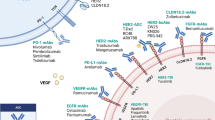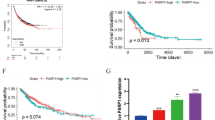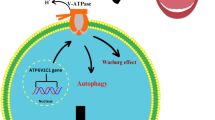Abstract
Background
Autophagy plays a major role in cellular homeostasis and is implicated in cancer progression. Damaged mitochondria are scavenged and eliminated by mitochondrial autophagy, referred to as mitophagy, which can promote cancer cell survival. This study investigated the expression and effects of the autophagy-related protein LC3 and the mitophagy-related protein Pink1 in human esophageal squamous cell carcinoma (ESCC).
Methods
Both LC3 and Pink1 were analyzed by immunohistochemistry in tissues from 217 ESCC patients, including 159 patients undergoing neoadjuvant chemotherapy. The relationships between LC3 and Pink1 expression and various clinicopathologic factors were determined. In vitro assays were performed to assess the role of LC3 and Pink1 in ESCC chemoresistance.
Results
High LC3 expression was observed in 47.9% and high Pink1 expression in 48.4% of the ESCC patients. Pink1 expression was significantly higher in patients who underwent chemotherapy than in patients who did not (p = 0.032). High LC3 and Pink1 expression was significantly correlated with poor response to chemotherapy (p = 0.004 and p < 0.001, respectively), and high expression of Pink1, but not LC3, was significantly correlated with a poor prognosis for patients treated with preoperative chemotherapy (p = 0.007). Multivariate analysis identified Pink1 expression as an independent prognostic factor (p = 0.042). In vitro assays demonstrated that LC3-II and Pink1 expression increased after chemotherapeutic treatment in the ESCC cell line, and inhibition of autophagy and mitophagy using chloroquine and siPink1, respectively, restored chemosensitivity.
Conclusions
High expression of Pink1 is associated with chemoresistance and a poor prognosis for ESCC patients undergoing neoadjuvant chemotherapy.



Similar content being viewed by others
References
Morita M, Otsu H, Kawano H, et al. Gender differences in prognosis after esophagectomy for esophageal cancer. Surg Today. 2014;44:505–12.
Pennathur A, Gibson MK, Jobe BA, Luketich JD. Oesophageal carcinoma. Lancet. 2013;381:400–12.
Ando N, Kato H, Igaki H, et al. A randomized trial comparing postoperative adjuvant chemotherapy with cisplatin and 5-fluorouracil versus preoperative chemotherapy for localized advanced squamous cell carcinoma of the thoracic esophagus (JCOG9907). Ann Surg Oncol. 2012;19:68–74.
Miyata H, Yoshioka A, Yamasaki M, et al. Tumor budding in tumor invasive front predicts prognosis and survival of patients with esophageal squamous cell carcinomas receiving neoadjuvant chemotherapy. Cancer. 2009;115:3324–34.
Okumura H, Uchikado Y, Setoyama T, et al. Biomarkers for predicting the response of esophageal squamous cell carcinoma to neoadjuvant chemoradiation therapy. Surg Today. 2014;44:421–8.
Levine B. Cell biology: autophagy and cancer. Nature. 2007;446:745–7.
He H, Dang Y, Dai F, et al. Post-translational modifications of three members of the human MAP1LC3 family and detection of a novel type of modification for MAP1LC3B. J Biol Chem. 2003;278:29278–87.
Mizushima N, Komatsu M. Autophagy: renovation of cells and tissues. Cell. 2011;147:728–41.
Yoshioka A, Miyata H, Doki Y, et al. LC3, an autophagosome marker, is highly expressed in gastrointestinal cancers. Int J Oncol. 2008;33:461–8.
White E. Deconvoluting the context-dependent role for autophagy in cancer. Nat Rev Cancer. 2012;12:401–10.
Yang S, Wang X, Contino G, et al. Pancreatic cancers require autophagy for tumor growth. Genes Dev. 2011;25:717–29.
Mathew R, Karantza-Wadsworth V, White E. Role of autophagy in cancer. Nat Rev Cancer. 2007;7:961–7.
Yang ZJ, Chee CE, Huang S, Sinicrope FA. The role of autophagy in cancer: therapeutic implications. Mol Cancer Ther. 2011;10:1533–41.
Sueda T, Sakai D, Kawamoto K, et al. BRAF(V600E) inhibition stimulates AMP-activated protein kinase-mediated autophagy in colorectal cancer cells. Sci Rep. 2016;6:18949.
Hamacher-Brady A, Brady NR. Mitophagy programs: mechanisms and physiological implications of mitochondrial targeting by autophagy. Cell Mol Life Sci. 2015.
Youle RJ, Narendra DP. Mechanisms of mitophagy. Nat Rev Mol Cell Biol. 2011;12:9–14.
Miyata H, Yamasaki M, Takahashi T, et al. Determinants of response to neoadjuvant chemotherapy for esophageal cancer using 18F-fluorodeoxiglucose positron emission tomography (18F-FDG-PET). Ann Surg Oncol. 2014;21:575–82.
Japanease Society for Esophageal Diseases. Guidelines for the Clinical and Pathologic Studies on Carcinoma of the Esophagus. 11th ed. Kanehara Syuppan, Tokyo, Japan, 2015.
Miyata H, Yamasaki M, Makino T, et al. Impact of number of [(18)F]fluorodeoxyglucose-PET-positive lymph nodes on survival of patients receiving neoadjuvant chemotherapy and surgery for oesophageal cancer. Br J Surg. 2016;103:97–104.
Berthier A, Navarro S, Jimenez-Sainz J, et al. PINK1 displays tissue-specific subcellular location and regulates apoptosis and cell growth in breast cancer cells. Hum Pathol. 2011;42:75–87.
Rambold AS, Kostelecky B, Elia N, Lippincott-Schwartz J. Tubular network formation protects mitochondria from autophagosomal degradation during nutrient starvation. Proc Natl Acad Sci USA. 2011;108:10190–5.
O’Flanagan CH, Morais VA, Wurst W, De Strooper B, O’Neill C. The Parkinson’s gene PINK1 regulates cell cycle progression and promotes cancer-associated phenotypes. Oncogene. 2015;34:1363–74.
Pridgeon JW, Olzmann JA, Chin LS, Li L. PINK1 protects against oxidative stress by phosphorylating mitochondrial chaperone TRAP1. PLoS Biol. 2007;5:e172.
MacKeigan JP, Murphy LO, Blenis J. Sensitized RNAi screen of human kinases and phosphatases identifies new regulators of apoptosis and chemoresistance. Nat Cell Biol. 2005;7:591–600.
Wang ZB, Peng XZ, Chen SS, et al. High p53 and MAP1 light chain 3A co-expression predicts poor prognosis in patients with esophageal squamous cell carcinoma. Mol Med Rep. 2013;8:41–6.
Sakurai T, Okumura H, Matsumoto M, et al. The expression of LC-3 is related to tumor suppression through angiogenesis in esophageal cancer. Med Oncol. 2013;30:701.
Chen Y, Li X, Wu X, et al. Autophagy-related proteins LC3 and Beclin-1 impact the efficacy of chemoradiation on esophageal squamous cell carcinoma. Pathol Res Pract. 2013;209:562–7.
Guo JY, Chen HY, Mathew R, et al. Activated Ras requires autophagy to maintain oxidative metabolism and tumorigenesis. Genes Dev. 2011;25:460–70.
Martinet W, Schrijvers DM, Timmermans JP, Bult H, De Meyer GR. Immunohistochemical analysis of macroautophagy: recommendations and limitations. Autophagy. 2013;9:386–402.
Schlafli AM, Adams O, Galvan JA, et al. Prognostic value of the autophagy markers LC3 and p62/SQSTM1 in early-stage non-small cell lung cancer. Oncotarget. 2016;7:39544–55.
Schlafli AM, Berezowska S, Adams O, Langer R, Tschan MP. Reliable LC3 and p62 autophagy marker detection in formalin-fixed paraffin-embedded human tissue by immunohistochemistry. Eur J Histochem. 2015;59:2481.
Karpathiou G, Sivridis E, Koukourakis MI, et al. Light-chain 3A autophagic activity and prognostic significance in non-small cell lung carcinomas. Chest. 2011;140:127–34.
Choi J, Jung W, Koo JS. Expression of autophagy-related markers beclin-1, light chain 3A, light chain 3B and p62 according to the molecular subtype of breast cancer. Histopathology. 2013;62:275–86.
Disclosure
There are no conflicts of interest.
Author information
Authors and Affiliations
Corresponding author
Electronic supplementary material
Below is the link to the electronic supplementary material.
10434_2017_6096_MOESM3_ESM.tif
Fig. S1 Correlation between LC3 and Pink1 expression and prognosis for esophageal squamous cell carcinoma (ESCC) patients. Overall survival according to (A) LC3 and (B) Pink1 expression in 217 ESCC patients with and without preoperative chemotherapy is shown. Supplementary material 3 (TIFF 1486 kb)
10434_2017_6096_MOESM4_ESM.tif
Fig. S2 Induction of LC3 by chemotherapeutic treatment in esophageal squamous cell carcinoma (ESCC) cells. A Western blot analysis of Pink1 and LC3 in ESCC cells after cisplatin exposure. TE11 cells were treated with cisplatin for 1, 2, 4, 8, or 12 h. B Western blot analysis of Pink1 and LC3 in ESCC cells after cisplatin exposure. TE11 cells were treated with 1.0, 2.0, 4.0, 8.0, or 16.0 µmol of cisplatin for 24 h. LC3 and Pink1 expression was measured using Western blot analyses. Supplementary material 4 (TIFF 107 kb)
10434_2017_6096_MOESM5_ESM.tif
Fig. S3 Immunofluorecent staining of LC3 in esophageal squamous cell carcinoma (ESCC) cells under the chemotherapeutic treatment. TE11 cells were treated with 8 µmol of cisplatin for 24 h. Cells were visualized using a confocal laser microscope (BZ-X710 microscope; objective × 200). Red dots correspond with accumulated LC3 in autophagosomes, and nuclei were stained with Hoechst 33342 (blue). Supplementary material 5 (TIFF 474 kb)
Rights and permissions
About this article
Cite this article
Yamashita, K., Miyata, H., Makino, T. et al. High Expression of the Mitophagy-Related Protein Pink1 is Associated with a Poor Response to Chemotherapy and a Poor Prognosis for Patients Treated with Neoadjuvant Chemotherapy for Esophageal Squamous Cell Carcinoma. Ann Surg Oncol 24, 4025–4032 (2017). https://doi.org/10.1245/s10434-017-6096-8
Received:
Published:
Issue Date:
DOI: https://doi.org/10.1245/s10434-017-6096-8




